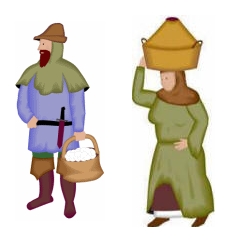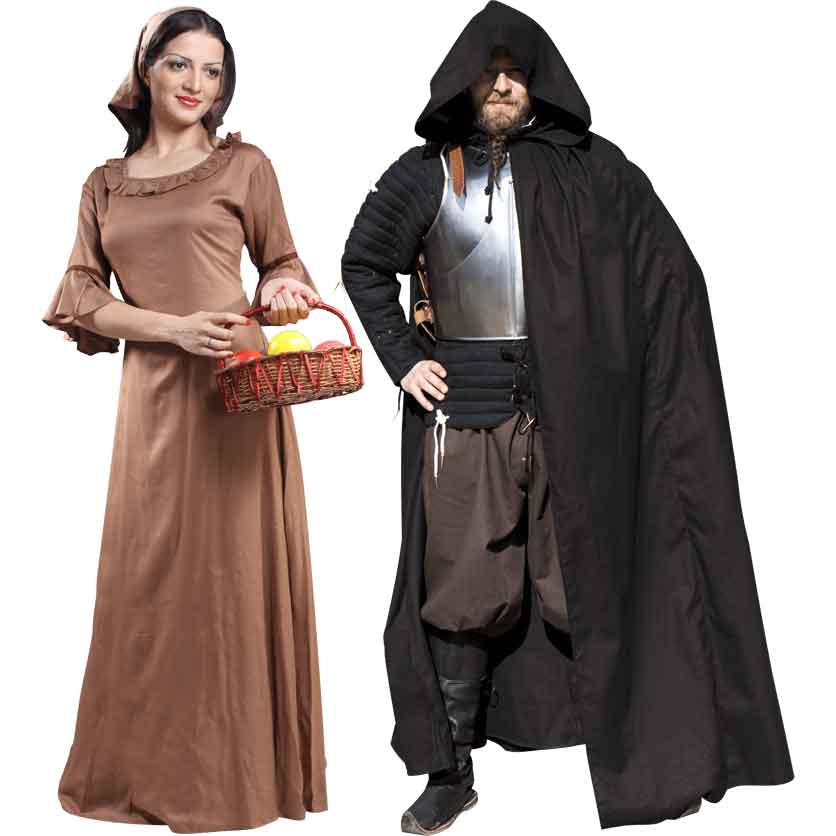Linen is easily laundered and was worn next to the skin with wool as the outer garment especially in colder weather. However this did not bother the peasants because they could not afford to purchase much.

Medieval And Period Medieval Clothing Peasant Medieval Clothing Renaissance Fashion
As the Western Roman Empire declined fashions were influenced by the sturdy protective garments of Barbarian peoples.

. Ad Enjoy Discounts Hottest Sales On Clothes Medieval. The mans wife is wearing a woollen dress over a woollen underskirt. Peasants considered wealthier than their counterparts such as Reeves were allowed to wear linen which was previously harvested from the flax plant.
Medieval peasant shoes Medieval shoes of peasants were normally made of animal skin such as calfskin or goatskin shoe laces were made from leatherMedieval peasants usually repaired their own clothing and shoes when they were worn out the soles of worn out shoes would often be replaced. What did the poor wear in medieval times. In cold weather both men and women wore cloaks made of sheepskin or wool.
Linen would now be used for Medieval Clothing instead of wool. Only had one set of clothes two at the most. The Catholic Church overwhelmingly shaped medieval peasant culture.
Most medieval peasants worked in the. The nobility and clergy were able to experiment more with luxurious fabrics and decorations but practicality was still a significant factor. Information on medieval clothing for costumers.
Peasant men like their female counterparts wore clothing that was more practical. Even men in lowest ranks of society however wore clothing that was short and tight consisting of tight drawers made of leather a tight tunic and a cape of cloak made of brown wool. The result was a synthesis of trousers and sleeved shirts with cloaks stolas and palliums.
In what they could afford peasants. He is wearing a small hat over a woollen cowl and boots on his feet. Up to 24 cash back During the middle ages 9 out of 10 people were peasants.
Although the life of a peasant was incredibly exhausting and grueling there was a vibrant tradition of pageants and festivals that reflected a rich medieval-peasant folk culture. They produced all the food in their society and paid most of the taxes. Peasants and working people wore a rough woven linen and wool.
The longer trousers that were worn by medieval peasants were usually tied with thongs. What was the clothing of peasants made of during the high middle ages. Clothes by spinning wool to make thread and then weaving their clothes.
Sheepskin cloaks and woolen hats and mittens were worn in. In a way fashion had a significance on the persons status in the social hierarchy The nobles wore luxurious materials that felt smooth on their skin while peasants wore rough materials as they worked hard in the lords manor. Fashion made a clear distinction between the different levels of the medieval social hierarchy.
For the medieval viewer color and material provided essential information about the social status of the figures on the page. Peasant men wore stockings or tunics while women wore long gowns with sleeveless tunics and wimples to cover their hair. A primary example of this can be seen with Carnival an enormous festival that occurred.
Today we provide an excellent selection of peasant clothing and peasant armour that will give anyone fantastic medieval style. Both men and women wore clogs made of thick leather. Medieval European Peasant Clothing The Ubiquitous Tunic.
Men wore tunics with either stockings or leggings over their tunics men would. In general medieval clothing was practical above all else particularly for the peasants and lower classes. What kind of jobs did medieval peasants do.
Peasants would make their own. Wearing undergarment a chemise. Most men and women in the Middle Ages had few items of clothing.
Peasants were typically limited in picking clothing because they did not have much money. It made the clothes more comfortable because the linen touched the skin and not the coarse wool. Peasants wore cheap undyed wool in shades of brown and gray.
The most common colors for peasant clothing were brown red or gray. Medieval peasants would usually wear a tunic short breeches or sometimes long trousers depending on the severity of the weather. 1400s workingman in unlaced hose rolled to the knees.
The man is wearing a short woollen tunic belted at the waist over short woollen trousers. Even worse the nobility would limit what the peasants could wear. Peasant working in his shirt c 1475.
Our peasant apparel includes many authentic looks that work well for Renaissance fairs theatrical productions LARP events and costume parties. Ad Find Deals on medieval peasant outfit in Womens Clothing on Amazon. Medieval Clothing of Peasants Early Medieval Period.
Would only have about one to two outfits to wear for many years. Wear a belt at the waist. Barley Tacuinum Sanitatis 1370-1400.
What did the rich wear in the Middle Ages. The clothing of peasants was basic practical and not decorated. Peasant reaping in linen braies and shirt and straw hat.
Peasants harvesting hay in tunics and shirts. Towards the end of the Middle Ages men of the wealthy classes. The basic garment worn by men women and children alike was a tunic.
For example scholars wore red robes that carried the additional prestige associated with the high cost of crimson dye. Medieval clothing would evolve from late antique garments and styles. Hats Hoods and Other Head-Coverings.

Peasants Medieval Peasant Medieval Clothing Peasant Medieval Clothing

Medieval Clothing Making A Statement In The Middle Ages History

Medieval Peasant Clothing Yahoo Image Search Results Medieval Peasant Medieval Middle Ages
/call-the-rain---ritual-898152828-6b88af7616914a989148408c84ae5f30.jpg)
What Peasants And Laborers Wore In The Medieval Ages

Peasant Clothing For Men Women And Children Medieval Collectibles

People Xiii Century Aragon Medieval Peasant Middle Ages Clothing Medieval Clothing

0 comments
Post a Comment